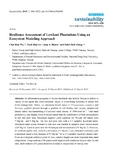Mostrar el registro sencillo del ítem
Resilience assessment of lowland plantations using an ecosystem modeling approach
| dc.creator | Wu, Chia-Hsin | es_ES |
| dc.creator | Lo, Yueh-Hsin | es_ES |
| dc.creator | Blanco Vaca, Juan Antonio | es_ES |
| dc.creator | Chang, Shih-Chieh | es_ES |
| dc.date.accessioned | 2015-12-30T09:25:50Z | |
| dc.date.available | 2015-12-30T09:25:50Z | |
| dc.date.issued | 2015 | |
| dc.identifier.issn | 2071-1050 | |
| dc.identifier.uri | https://hdl.handle.net/2454/19809 | |
| dc.description.abstract | As afforestation programs of former farmlands take hold in Taiwan to achieve a variety of ecological and socio-economic values, it is becoming necessary to define best forest management. Hence, we simulated mixed stands of Cinnamomum camphora and Fraxinus griffithii planted through a gradient of soil fertility and varying camphor/ash density ratios, but maintaining a fixed total stand density of 1500 trees ha −1 . Total stand productivity was slightly lower in mixed stands than the combination of both monocultures in rich and poor sites. Maximum negative yield surpluses for 50-year old stands were 7 Mg ha −1 and 6 Mg ha −1 for rich and poor sites with a 1:1 camphor laurel/ash ratios. Maximum stand woody biomass in rich sites was reached in camphor laurel monocultures (120 Mg ha −1 ) and in poor sites for Himalayan ash monocultures (58 Mg ha −1 ). However, for medium-quality sites, a small yield surplus (11 Mg ha −1 ) was estimated coinciding with a maximum stand woody biomass of 95 Mg ha −1 for a 1:1 camphor laurel/ash density ratio. From an ecological resilience point of view, rotation length was more important than stand composition. Long rotations (100 years) could improve soil conditions in poor sites. In rich sites, short rotations (50 years) should be avoided to reduce risks or fertility loss. | en |
| dc.description.sponsorship | Yueh-Hsin Lo was funded by the Spanish Ministry of Economy and Competitiveness (Ref. AGL2012-33465). Juan A. Blanco was funded through a “Ramón y Cajal” contract (Ref. RYC-2011-08082) and a Marie Curie Action (Ref. CIG-2012-326718-ECOPYREN3). Shih-Chieh Chang was given a grant by the Ministry of Science and Technology (Ref. NSC 102-2621-M-259-005) | en |
| dc.format.mimetype | application/pdf | en |
| dc.language.iso | eng | en |
| dc.publisher | MDPI | en |
| dc.relation.ispartof | Sustainability 2015, 7, 3801-3822 | en |
| dc.rights | © 2015 by the authors; licensee MDPI, Basel, Switzerland. This article is an open access article distributed under the terms and conditions of the Creative Commons Attribution license (http://creativecommons.org/licenses/by/4.0/). | en |
| dc.rights.uri | http://creativecommons.org/licenses/by/4.0/ | |
| dc.subject | Mixed forests | en |
| dc.subject | Artificial forest | en |
| dc.subject | Ecological modeling | en |
| dc.subject | Resilience | en |
| dc.subject | Ecological sustainability | en |
| dc.subject | Camphor laurel | en |
| dc.subject | Himalayan ash | en |
| dc.subject | FORECAST model | en |
| dc.title | Resilience assessment of lowland plantations using an ecosystem modeling approach | en |
| dc.type | Artículo / Artikulua | es |
| dc.type | info:eu-repo/semantics/article | en |
| dc.contributor.department | Ciencias del Medio Natural | es_ES |
| dc.contributor.department | Natura Ingurunearen Zientziak | eu |
| dc.rights.accessRights | Acceso abierto / Sarbide irekia | es |
| dc.rights.accessRights | info:eu-repo/semantics/openAccess | en |
| dc.identifier.doi | 10.3390/su7043801 | |
| dc.relation.projectID | info:eu-repo/grantAgreement/European Commission/FP7/326718 | en |
| dc.relation.projectID | info:eu-repo/grantAgreement/MINECO//AGL2012-33465/ES/ | en |
| dc.relation.publisherversion | https://dx.doi.org/10.3390/su7043801 | |
| dc.type.version | Versión publicada / Argitaratu den bertsioa | es |
| dc.type.version | info:eu-repo/semantics/publishedVersion | en |



